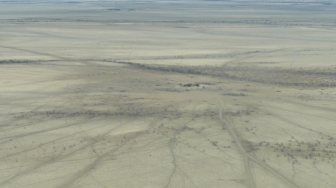
Date: Thursday, October 8, 2015
Project: Eastern Australian Waterbird Survey
Observer: Terry Korn
Today we headed west to Mt Isa, along the most northern band 10. Sixty two per cent of the wetlands we visited today were dry. Only three large storage dams held sufficient water to attract significant numbers of waterbirds. The Proserpine Dam held 73%; Burdekin Falls dam 59% and Lake Moondarra at Mt Isa 50%; they reflect the grip of the drought. All wetlands are clearly suffering from the drought which is impacting on northern and western Queensland. Only parts of the Bowen River and the Burdekin River held water and all creeks were dry.
Proserpine dam was relatively small but a haven for Eurasian coot. Hundreds formed large rafts along the shore lines of this popular lure fishing lake while the dead trees attract many Little black cormorants and darters. Our low level flying clearly bemuses the fishermen watching us from their tinnies as they try their luck.
The Burdekin Falls dam is the largest in Queensland and is at the lowest level I have seen it since I began on these surveys in 2008. Nonetheless such a large body of water attracts many species, the most numerous generally being cormorants and coot. This time I counted one group of 2000 little black cormorants and many hundreds of coot while pied cormorants consistently were added to the digital recorders. I have previously only seen such large groups of cormorants winging their way up Coopers Creek, near Windorah.
Grazing lands west of the range are now mostly de-stocked as the country is without any ground cover. The few cattle remaining hang around the few active watering points hoping that this year the wet season will be wet once again.
Drought country north of Julia Creek. Photo: Terry Korn
Lake Moondarra provides water to Mt Isa and is a favourite haunt of hardhead ducks which today were the most abundant species. They formed many tight rafts and behaviour wise cluster much closer than Eurasian coot to form tight balls of black on the water’s surface. Hardhead are very easily identified once they fly, displaying the white trailing edge of their wings. Their swift wing beat is another identifier.
